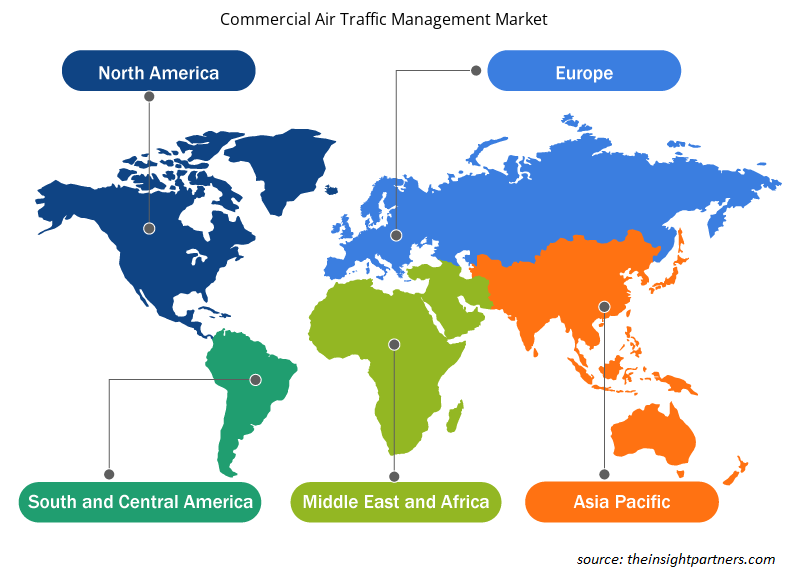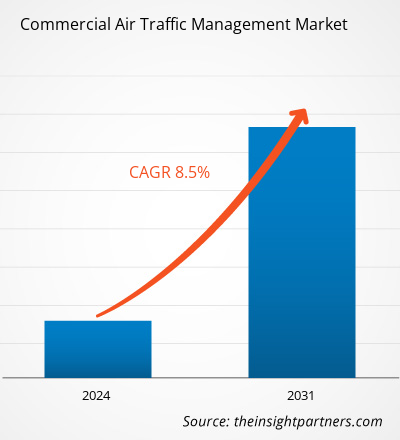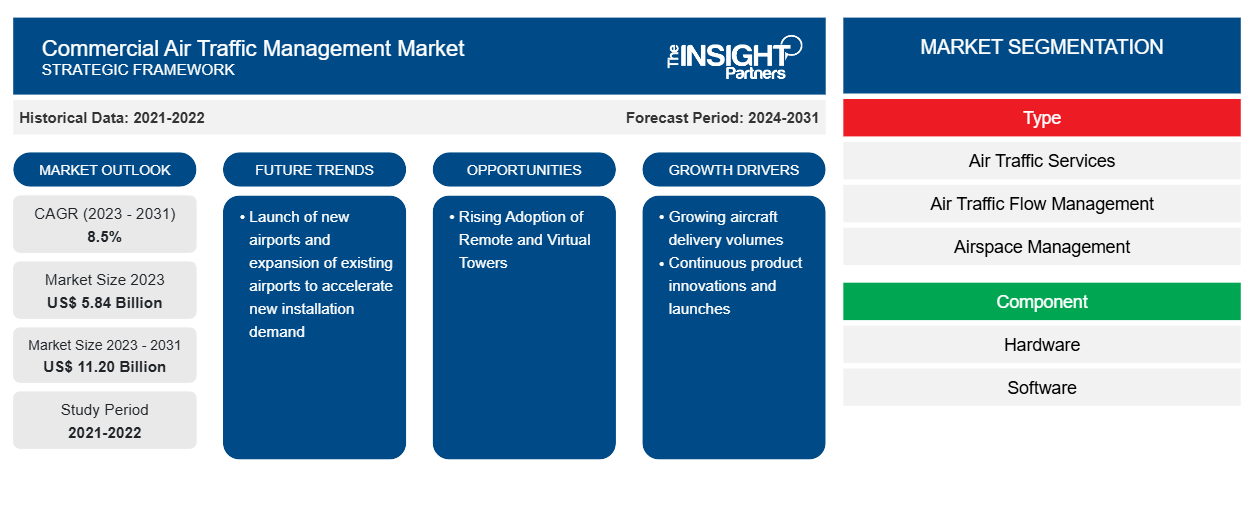Der Markt für kommerzielles Flugverkehrsmanagement soll von 5,84 Milliarden US-Dollar im Jahr 2023 auf 11,20 Milliarden US-Dollar im Jahr 2031 anwachsen. Der Markt wird zwischen 2023 und 2031 voraussichtlich eine durchschnittliche jährliche Wachstumsrate (CAGR) von 8,5 % verzeichnen. Die Eröffnung neuer Flughäfen und die Erweiterung bestehender Flughäfen zur Beschleunigung der Nachfrage nach Neuinstallationen dürften weiterhin ein wichtiger Trend auf dem Markt bleiben.CAGR of 8.5% during 2023–2031. Launch of new airports and expansion of existing airports to accelerate new installation demand is likely to remain a key trend in the market.
Marktanalyse für kommerzielles Flugverkehrsmanagement
Zu den Käufern des Marktes für kommerzielles Flugverkehrsmanagement zählen Verkehrsflughäfen und ihre Behörden, die zunehmend in die Beschaffung fortschrittlicher Lösungen für das Flugverkehrsmanagement (ATM) für einen effizienten und sicheren Flugbetrieb investieren. Derzeit laufen die Flughafenbauprojekte, wodurch die Kaufkraft der Käufer moderat ist. Gegen Ende der Flughafenbauarbeiten wird die Nachfrage nach ATM-Lösungen jedoch steigen, wodurch die Verhandlungsmacht der Käufer steigt. Darüber hinaus ist die Lebensdauer kommerzieller ATM-Systeme hoch, was derzeit zu einer geringen Verhandlungsmacht der Käufer führt. Während der Aktualisierung neuer ATM-Systeme an Flughäfen, insbesondere der bestehenden, wird jedoch erwartet, dass die Verhandlungsmacht der Käufer in den kommenden Jahren steigen wird.
Marktübersicht für kommerzielles Flugverkehrsmanagement
Zu den wichtigsten Akteuren im globalen Ökosystem des kommerziellen Flugverkehrsmanagementmarkts zählen Komponentenhersteller, Hardwarehersteller, Softwareanbieter, Regierungsbehörden und Endnutzer. Die Komponentenhersteller, die auf dem globalen Markt für kommerzielles Flugverkehrsmanagement tätig sind, bieten Sender, Antennen, Empfänger, Anzeigen, Batterien, Lichter, Sensoren und andere Geräte an. Die rechtzeitige Lieferung all dieser Komponenten ist für einen effizienten Betrieb in den Produktionsstätten für Flugverkehrsmanagementsysteme von entscheidender Bedeutung. Wenn es zu betrieblichen Auswirkungen auf diese Komponentenanbieter kommt, kommt es zu Verzögerungen bei der Produktion von Flugverkehrsmanagementsystemen , was sich unmittelbar auf den Markt für kommerzielles Flugverkehrsmanagement auswirkt.
Passen Sie diesen Bericht Ihren Anforderungen an
Sie erhalten kostenlos individuelle Anpassungen an jedem Bericht, einschließlich Teilen dieses Berichts oder einer Analyse auf Länderebene, eines Excel-Datenpakets sowie tolle Angebote und Rabatte für Start-ups und Universitäten.
-
Holen Sie sich die wichtigsten Markttrends aus diesem Bericht.Dieses KOSTENLOSE Beispiel umfasst eine Datenanalyse von Markttrends bis hin zu Schätzungen und Prognosen.
Treiber und Chancen auf dem Markt für kommerzielles Flugverkehrsmanagement
Kontinuierliche Produktinnovationen und -einführungen
Die globale Luftfahrtindustrie befindet sich im Wandel, was neue und innovative Produkte betrifft. Die Akteure aller Branchen investieren kontinuierlich in Forschung und Entwicklung, um Innovationen zu schaffen und robuste Lösungen zu entwickeln, die den industriellen Betrieb vereinfachen. Die wachsende Nachfrage nach Flugverkehrsmanagementsystemen zwang die Marktteilnehmer in den letzten Jahren dazu, in die Entwicklung neuer und innovativer Produkte zu investieren. Im Folgenden sind einige der wichtigsten Produktentwicklungen aufgeführt:
- Im Juli 2022 veröffentlichte EUROCONTROL einen aktualisierten Überwachungstracker und -server für das Flugverkehrsmanagement (ARTAS). Die neue Version (V 9.0.2) verfügt über mehrere neue Community-Funktionen, und die Probleme sollen darin behoben sein.
- Im Juni 2022 gaben Indra Sistemas SA und das Upper Area Control Centre (MUAC) von Eurocontrol Maastricht die Einführung eines Aeronautical Telecommunications Network (ATN) und eines Automatic Dependent Surveillance Contract-Systems (ADS-C) bekannt, das es Flugsicherungssystemen ermöglicht, den Flugverkehr präzise zu steuern.
- Im Juni 2022 kündigte Thales SA die Einführung von HELIXVIEW an, einem C3-kompatiblen Scanner, der elektronisches Scannen auf Röntgen-Nanotechnologiebasis und 3D-Bildrekonstruktion kombiniert, um Flughäfen mehr Sicherheit und Passagieren nahtlose Reisemöglichkeiten zu bieten.
Solche Entwicklungen haben das Wachstum des Marktes für kommerzielles Flugverkehrsmanagement weltweit vorangetrieben.
Zunehmende Nutzung von Remote- und virtuellen Türmen
Die Remote- und virtuellen Tower helfen dabei, den Flugverkehr aus der Ferne zu regulieren und aufrechtzuerhalten. Verschiedene Flughäfen weltweit haben diese Tower für einen schnelleren und sichereren Flughafenbetrieb eingeführt. Im Juni 2022 eröffnete der Flughafen Brindisi in Italien seinen ersten ferngesteuerten Kontrollturm. Der neue Remote-Digital-Tower wird Fluglotsen dabei helfen, Start, Landung und Bodenbetrieb von einem Remote-Tower-Modul aus zu verwalten. Das Modul wird auch das Flugverkehrsmanagement unterstützen und die Sicherheit und Betriebseffizienz des Flughafens verbessern. Im Mai 2022 wurde bekannt gegeben, dass die Flughäfen Braunschweig-Wolfsburg und Emden in Norddeutschland die DFS Aviation Services GmbH (DAS) und Frequentis mit dem Bau eines Remote-Tower-Zentrums in der Region beauftragt haben, das Mitte 2024 in Betrieb gehen soll. Daher wird erwartet, dass die zunehmende Einführung und Investition in Remote- und virtuelle Tower für ein effizientes Flugverkehrsmanagement das Wachstum des Marktes für kommerzielles Flugverkehrsmanagement ankurbeln wird.
Segmentierungsanalyse des Marktberichts zum kommerziellen Flugverkehrsmanagement
Wichtige Segmente, die zur Ableitung der Marktanalyse für das kommerzielle Flugverkehrsmanagement beigetragen haben, sind Typ, Komponente, Anwendung und Flughafenklasse.
- Der Markt für kommerzielles Flugverkehrsmanagement ist nach Typ in Flugverkehrsdienste, Flugverkehrsflussmanagement und Luftraummanagement unterteilt . Das Segment Luftraummanagement hatte im Jahr 2023 einen größeren Marktanteil.
- Basierend auf den Komponenten ist der Markt für kommerzielles Flugverkehrsmanagement in Hardware und Software unterteilt. Das Hardwaresegment hatte im Jahr 2023 einen größeren Marktanteil. Das Hardwaresegment ist weiter unterteilt in Radare, Antennen, Anzeigesysteme und andere.
- Basierend auf der Anwendung ist der Markt für kommerzielles Flugverkehrsmanagement in Kommunikation, Navigation, Überwachung, Verkehrskontrolle und andere unterteilt. Das Überwachungssegment hatte 2023 einen größeren Marktanteil. Das Navigationssegment ist weiter unterteilt in CVOR, DVOR, DME, ILS, DF und NDB. Das Überwachungssegment ist weiter unterteilt in PSR, SSR und MLAT.
- Basierend auf der Flughafenklasse ist der Markt für kommerzielles Flugverkehrsmanagement in Klasse I, Klasse II, Klasse III und Klasse IV unterteilt. Das Segment Klasse I hatte im Jahr 2023 einen größeren Marktanteil.
Marktanteilsanalyse für das kommerzielle Flugverkehrsmanagement nach geografischer Lage
Der geografische Umfang des Marktberichts zum kommerziellen Flugverkehrsmanagement ist hauptsächlich in fünf Regionen unterteilt: Nordamerika, Europa, Asien-Pazifik, Naher Osten und Afrika sowie Südamerika.
Nordamerika dominierte den Markt im Jahr 2023, gefolgt von Europa und dem asiatisch-pazifischen Raum. Darüber hinaus wird der asiatisch-pazifische Raum den nordamerikanischen Markt in den kommenden Jahren wahrscheinlich überholen und die höchste durchschnittliche jährliche Wachstumsrate aufweisen. Die USA dominierten den nordamerikanischen Markt für kommerzielles Flugverkehrsmanagement im Jahr 2023. Dies liegt hauptsächlich daran, dass die US-Luftfahrtindustrie eines der wichtigsten Länder im globalen Luftfahrtsektor ist. Das Land verfügt über die größte Flugzeugflotte, die Millionen von Passagieren pro Jahr befördert. So befördert die US-Fluggesellschaft im Jahr 2023 mehr als 862 Millionen Passagiere. Der Anstieg des Passagierverkehrs führt dazu, dass die US-Fluggesellschaften eine größere Anzahl von Flugzeugflotten anschaffen und einen höheren Bedarf an ATM-Operationen erzeugen. Darüber hinaus katalysieren die Modernisierung bestehender ATC-Türme an verschiedenen US-Flughäfen und die Inbetriebnahme neuer ATC-Türme an verschiedenen Flughäfen in den USA das Wachstum des Marktes für kommerzielles Flugverkehrsmanagement im ganzen Land. Mehrere Flughäfen im ganzen Land haben verschiedene Expansionsprozesse durchlaufen, die auch den Bau neuer Terminals, ATC-Türme und die Modernisierung anderer Sektoren an den Flughäfen umfassen. So hat beispielsweise der Phoenix-Mesa Gateway Airport im August 2022 einen ATC-Tower in Betrieb genommen, um den wachsenden Flugverkehr auf dem Flughafen in Arizona abzuwickeln. Ebenso setzt die Federal Aviation Administration (FAA) mehrere Flughafenpläne um, um ihre Flugverkehrsmanagementsysteme für die Umgestaltung des US-Luftraums zu modernisieren und so ihre Sicherheit, Effizienz und Umweltverantwortung zu verbessern. Solche Faktoren haben das Wachstum des US-Marktes für kommerzielles Flugverkehrsmanagement in der Region Nordamerika vorangetrieben.
Regionale Einblicke in den Markt für kommerzielles Flugverkehrsmanagement
Die regionalen Trends und Faktoren, die den Markt für kommerzielles Flugverkehrsmanagement im Prognosezeitraum beeinflussen, wurden von den Analysten von Insight Partners ausführlich erläutert. In diesem Abschnitt werden auch Marktsegmente und Geografie des kommerziellen Flugverkehrsmanagements in Nordamerika, Europa, im asiatisch-pazifischen Raum, im Nahen Osten und Afrika sowie in Süd- und Mittelamerika erörtert.

- Erhalten Sie regionale Daten zum Markt für kommerzielles Flugverkehrsmanagement
Umfang des Marktberichts zum kommerziellen Flugverkehrsmanagement
| Berichtsattribut | Details |
|---|---|
| Marktgröße im Jahr 2023 | 5,84 Milliarden US-Dollar |
| Marktgröße bis 2031 | 11,20 Milliarden US-Dollar |
| Globale CAGR (2023 - 2031) | 8,5 % |
| Historische Daten | 2021-2022 |
| Prognosezeitraum | 2024–2031 |
| Abgedeckte Segmente |
Nach Typ
|
| Abgedeckte Regionen und Länder |
Nordamerika
|
| Marktführer und wichtige Unternehmensprofile |
|
Marktteilnehmerdichte: Der Einfluss auf die Geschäftsdynamik
Der Markt für kommerzielles Flugverkehrsmanagement wächst rasant, angetrieben durch die steigende Nachfrage der Endnutzer aufgrund von Faktoren wie sich entwickelnden Verbraucherpräferenzen, technologischen Fortschritten und einem größeren Bewusstsein für die Vorteile des Produkts. Mit steigender Nachfrage erweitern Unternehmen ihr Angebot, entwickeln Innovationen, um die Bedürfnisse der Verbraucher zu erfüllen, und nutzen neue Trends, was das Marktwachstum weiter ankurbelt.
Die Marktteilnehmerdichte bezieht sich auf die Verteilung der Firmen oder Unternehmen, die in einem bestimmten Markt oder einer bestimmten Branche tätig sind. Sie gibt an, wie viele Wettbewerber (Marktteilnehmer) in einem bestimmten Marktraum im Verhältnis zu seiner Größe oder seinem gesamten Marktwert präsent sind.
Die wichtigsten auf dem Markt für kommerzielles Flugverkehrsmanagement tätigen Unternehmen sind:
- Thales SA
- BAE Systems Plc
- Indra Sistemas SA
- L3Harris Technologies Inc
- Raytheon Technologies Corp
- Honeywell International Inc
Haftungsausschluss : Die oben aufgeführten Unternehmen sind nicht in einer bestimmten Reihenfolge aufgeführt.

- Überblick über die wichtigsten Akteure auf dem Markt für kommerzielles Flugverkehrsmanagement
Neuigkeiten und aktuelle Entwicklungen zum Markt für kommerzielles Flugverkehrsmanagement
Der Markt für kommerzielles Flugverkehrsmanagement wird durch die Erhebung qualitativer und quantitativer Daten nach Primär- und Sekundärforschung bewertet, die wichtige Unternehmensveröffentlichungen, Verbandsdaten und Datenbanken umfasst. Nachfolgend sind einige der Entwicklungen auf dem Markt für kommerzielles Flugverkehrsmanagement aufgeführt:
- Im Rahmen des 2014 mit der Zambia Airports Corporation Limited (ZACL) unterzeichneten Vertrags modernisiert Thales die ATC-Zentren (Flugsicherung) an den internationalen Flughäfen Lusaka und Livingstone in Sambia. (Quelle: Thales, Pressemitteilung, Oktober 2023)
- EUROCONTROL MUAC und Indra haben ein innovatives ATN Automatic Dependent Surveillance Contract-System (ADS-C) für den automatisierten Datenaustausch mit Flugzeugen im Flug implementiert, um die Genauigkeit der Verkehrssteuerung zu erhöhen. Es wird die Vorhersagbarkeit verbessern, eine frühzeitige Konflikterkennung erleichtern und der erste Schritt in Richtung Trajectory Based Operations (TBO) sein. Es wird auch den Steig- und Sinkflug von Flugzeugen optimieren, sie länger auf optimaler Flughöhe halten und den Treibstoffverbrauch minimieren (Quelle: Indra, Pressemitteilung, Juni 2022)
Marktbericht zum kommerziellen Flugverkehrsmanagement – Abdeckung und Ergebnisse
Der Bericht „Marktgröße und Prognose für kommerzielles Flugverkehrsmanagement (2021–2031)“ bietet eine detaillierte Analyse des Marktes, die die folgenden Bereiche abdeckt:
- Marktgröße und Prognose für das kommerzielle Flugverkehrsmanagement auf globaler, regionaler und Länderebene für alle wichtigen Marktsegmente, die im Rahmen des Berichts abgedeckt sind
- Markttrends und Marktdynamiken im Bereich des kommerziellen Flugverkehrsmanagements, wie Treiber, Einschränkungen und wichtige Chancen
- Detaillierte Porter-Fünf-Kräfte-Analyse
- Marktanalyse für kommerzielles Flugverkehrsmanagement mit wichtigen Markttrends, globalen und regionalen Rahmenbedingungen, wichtigen Akteuren, Vorschriften und aktuellen Marktentwicklungen
- Branchenlandschaft und Wettbewerbsanalyse, einschließlich Marktkonzentration, Heatmap-Analyse, prominenten Akteuren und aktuellen Entwicklungen für den Markt für kommerzielles Flugverkehrsmanagement
- Detaillierte Firmenprofile
- Historische Analyse (2 Jahre), Basisjahr, Prognose (7 Jahre) mit CAGR
- PEST- und SWOT-Analyse
- Marktgröße Wert/Volumen – Global, Regional, Land
- Branchen- und Wettbewerbslandschaft
- Excel-Datensatz
Aktuelle Berichte
Verwandte Berichte
Erfahrungsberichte
Grund zum Kauf
- Fundierte Entscheidungsfindung
- Marktdynamik verstehen
- Wettbewerbsanalyse
- Kundeneinblicke
- Marktprognosen
- Risikominimierung
- Strategische Planung
- Investitionsbegründung
- Identifizierung neuer Märkte
- Verbesserung von Marketingstrategien
- Steigerung der Betriebseffizienz
- Anpassung an regulatorische Trends























 Kostenlose Probe anfordern für - Markt für kommerzielles Flugverkehrsmanagement
Kostenlose Probe anfordern für - Markt für kommerzielles Flugverkehrsmanagement